CEDAR HILL CEMETERY
SUFFOLK, VIRGINIA

In the 17th and 18th centuries, tobacco was the moneymaking crop of colonial Virginia and Nansemond County. In 1712, to store this crop, John Constant built a warehouse just beyond the present-day cemetery, where the Hilton Garden Inn Suffolk Riverfront now stands. He also built his house up on the hill, overlooking his warehouse. By 1730, John Constant’s warehouse became a prosperous trading point. This area was then known as Constant’s Warehouse. It was because of this prosperity the Constant family led a petition to establish a town here.
In 1742, the settlement was chartered as the Town of Suffolk.
After the Revolutionary War, the Anglican Church (Church of England) that was located at what is now Western Avenue was abandoned and fell into neglect. It was eventually torn down. For years, there was no church in old town of Suffolk. In 1802, the town of Suffolk purchased two and a half acres up on the hill (on part of what was John Constant’s farm) to build a community chapel. Residents needed a place to bury their loved ones, so the area surrounding the chapel became a burial ground.
Once the various religious denominations started to build their places of worship, the chapel was no longer needed. It was moved to Pine Street and is still used today, although it has been remodelled and added to over the years (Macedonia African Methodist Episcopal Church, A.M.E.).
This area was then known as Green Hill Cemetery, or Union Cemetery on some maps. Wilbur Kilby,
a superintendent of the cemetery in the late 1800s, planted the cedars and laid out the “streets.” The area then became known as Cedar Hill Cemetery. Today, Cedar Hill is 32 acres in size and the final resting place of many prominent citizens and luminaries, including:
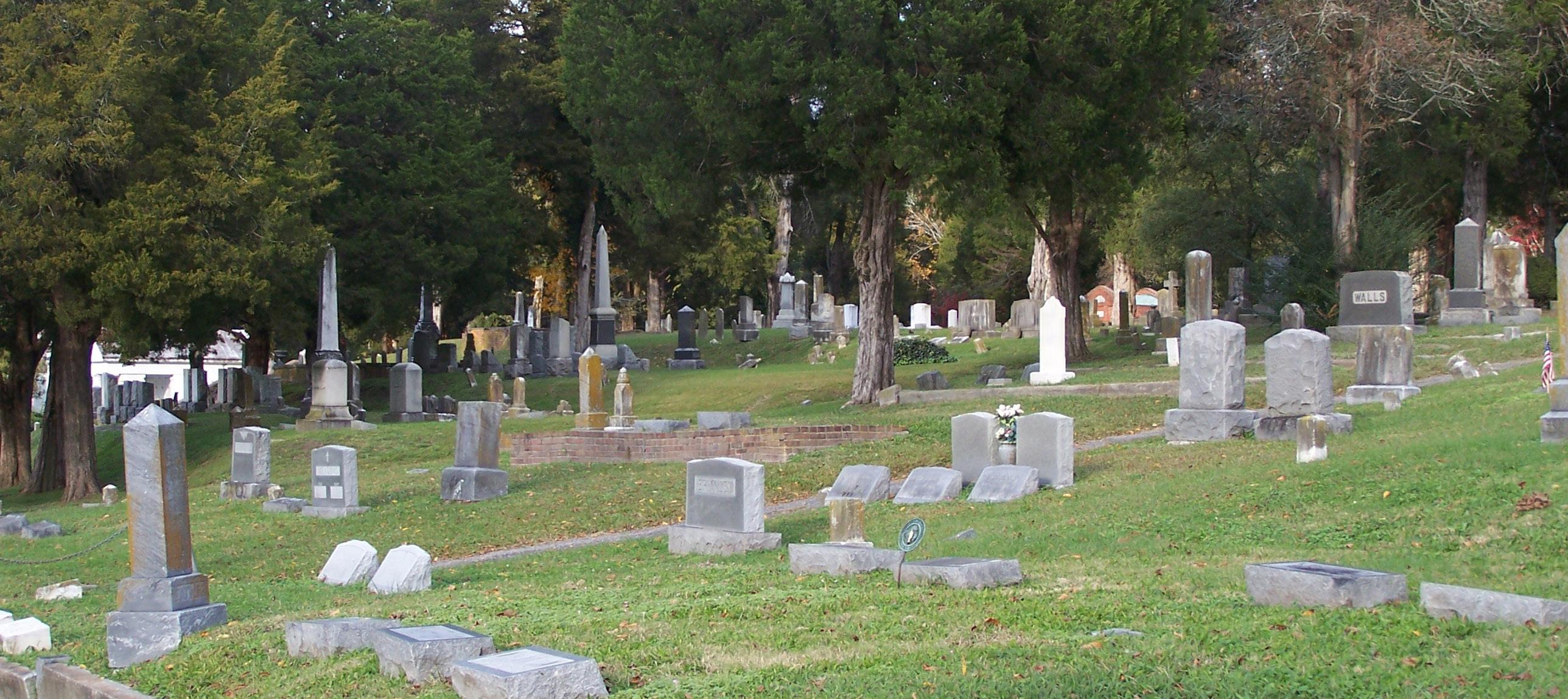
• A United States Congressman
• A Governor of Virginia
• A Lieutenant Governor
• A Speaker of the House of Delegates of Virginia
• A president of the Garden Club of Virginia
• A three-star General
• And even a circus lion trainer!
Walking through Cedar Hill Cemetery is like walking through the pages of Suffolk’s history.

INTRODUCTION TO CEDAR HILL CEMETERY
2
Cedar Hill Cemetery is located in the heart of historic downtown Suffolk. Entrances are located on Mahan Street, Constance Road, and behind the Suffolk Seaboard Railroad Museum. The cemetery is open daily from dawn to dusk and is maintained by the City of Suffolk’s Department of Parks and Recreation.
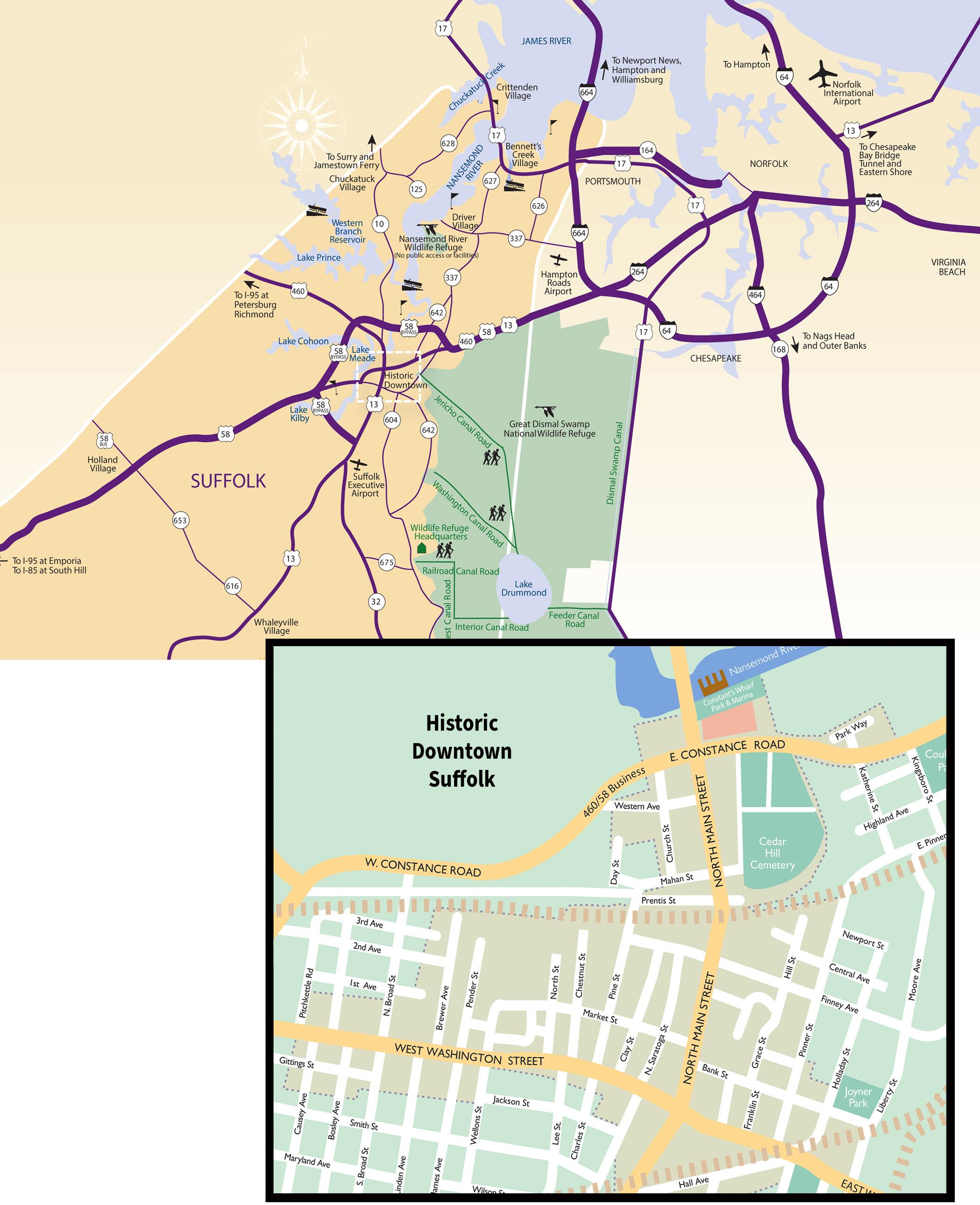
3
Colonial Suffolk
In the summer of 1608, Captain John Smith sailed up the Nansemond River to the home of the Nansemond Indians. The word “Nansemond” meant “fishing angle” and described the location of the Indians’ main village at the mouth of the Western Branch. A year later, when starvation threatened the survival of Jamestown, Smith sent Captain John Martin to found a settlement on the site. The new settlement failed because of conflict with the Indians. In the years that followed, the Nansemonds lost their lives and their lands to the English such that by 1744, there were so few left that they joined the Nottoways to the west.

The land south of the James River was well suited to the production of tobacco, and around 1720, John Constant built a warehouse on the riverfront for the trade of tobacco. A community called Constant’s Wharf developed around the warehouse. In 1742, the House of Burgesses approved a bill “to establish a town at Constant’s Warehouse, on the Nansemond River, to be called Suffolk!”
In 1767, George Washington, Fielding Lewis, and Thomas Walker obtained a grant for much of the land in the Dismal Swamp and formed the Great Dismal Swamp Land Company. This company dug the Washington Ditch, as well as the Jericho Canal, which connected Lake Drummond in the swamp with Shingle Creek and the Nansemond River. A lucrative trade developed in lumber, tar, pitch, shingles, and other wood products on the Nansemond, further strengthening the economy of the fledgling town of Suffolk.
In May 1779, British General Matthews led a force of 600 troops toward Suffolk after taking control of Norfolk and Portsmouth. The Nansemond Militia, only 200 strong
and mostly unarmed, assembled to meet them. By the following day, May 13, the Militia had dwindled to 100 and was no match for the approaching enemy.
The British burned the town of Suffolk. The waterfront warehouses, with their stores of tar, pitch, and turpentine, spread the fire across and along the river. It was recalled that “This immense sheet of fire . . . contributed to form a collective scene of horror and sublimity such as could not be viewed without emotions not to be described.”
Early Suffolk grew from the waterfront southward along Main Street, with most of the structures being built of wood. Just after noon on June 3, 1837, a fire broke out in the cabinet shop of Edward Arnold, a quarter mile south of this point. Fanned by a strong southwest wind, the flames spread along Main Street and destroyed most of the town of Suffolk. Among the 130 buildings lost were the courthouse, the jail, and numerous residences.
After the fire, construction began on a new courthouse building that stands before you today. It was built of brick, to be more resistant to fires than the two courthouse buildings that had previously occupied the site. The first had been lost when the British had burned the town 58 years earlier.
Mills Riddick, a wealthy landowner and prominent citizen of Suffolk, lost several properties in the fire, including his own residence on Main Street. Mr. Riddick used the proceeds from the insurance on his other buildings to build for himself a new brick mansion on two lots next
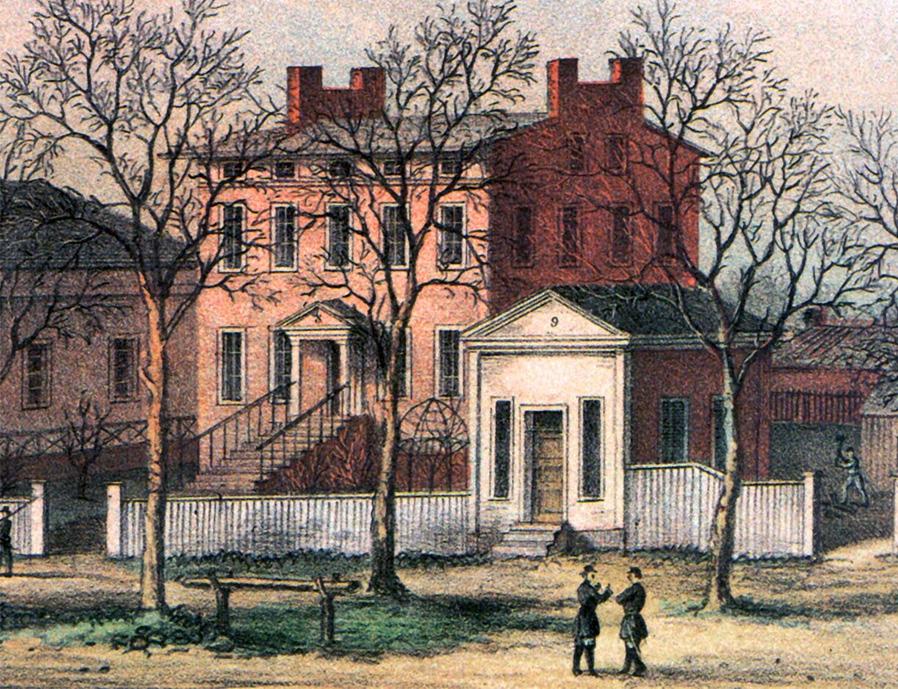 Riddick’s Folly and The Nansemond County Courthouse
Engraving from John White’s drawing
Riddick’s Folly and The Nansemond County Courthouse
Engraving from John White’s drawing
A BRIEF HISTORY OF SUFFOLK 4
Riddick’s Folly During the Civil War—from an 1863 lithograph
door to the Courthouse. According to tradition, the local citizens referred to the lavish home as “Riddick’s Folly.”
After Norfolk surrendered to the Union forces, most of the well-to-do families, including the Riddicks, packed up, boarded trains and left town. Union troops occupied the town of Suffolk during the Civil War from May 1862 until June 1863. During most of that time, Major General John J. Peck commanded the 15,000 troops, and his headquarters were in Riddick’s Folly. When the Union Troops left, they ransacked the place and took most of the furnishings. The building has now been restored and its walls still bear graffiti from the men who occupied the house. It is thought that the oldest Riddick daughter, Anna Mary, loved her tutor, Jonathan Smith, who was killed in action near Richmond. She lived to be 95 and like many of the young women of the time, she never married. Her grave is in Cedar Hill.
Suffolk Civil War Map
After the outbreak of the War Between the States, most of the young men of Suffolk and Nansemond County enlisted in the Confederate army and left their homes for war. During the first year of the war, a training camp was established in Suffolk for new recruits from states farther south, and their presence was a comfort to the citizens who remained at home.

On May 10, 1862, after the fall of Norfolk to the Union forces, the Confederates withdrew to the Blackwater River, 20 miles west. Two days later, members of the 1st New York Mounted Rifles rode into Suffolk and later assumed control of the town. Soon there were 15,000 Union troops camped in fields all around Suffolk. In September, Major General John J. Peck took command of the Union forces and ordered the construction of a ring of earthwork forts, batteries, and trenches around Suffolk.
In April 1863, General James Longstreet’s corps of 20,000 Confederate troops surrounded the north, west, and south sides of Suffolk as they sent forage wagons through the countryside to purchase the food supplies for the Confederate army. The Federals, commanded by General Peck, erected new earthworks along the east bank of the Nansemond River to resist any attempt by the Confederates to cross.
This map, showing Suffolk and the Nansemond River during Longstreet’s campaign, was drawn by John E. Morris, a Union soldier of the 22nd Connecticut Infantry.

General Robert E. Lee, commanding the Confederate forces in Virginia, recalled Longstreet and his command to help resist the Union army’s push to take Richmond. Longstreet arrived too late to assist Lee in defeating Union General Joseph Hooker at the Battle of Chancellorsville.
One half mile east stood Union Town, a camp built by slaves who had escaped or been freed by Union troops occupying Suffolk in 1862-63. The “contraband camp,” as it was sometimes called, was described by a Rhode Island officer as “a large village, compactly built of split hemlock boards, and all its inhabitants were ‘contrabands,’” who had left their masters and found refuge within our lines. The style of the exterior of some of (the buildings) would be credible to a summer resort like Martha’s Vineyard.” The camp was laid out in streets, and included one building used as a school and church. Union Town residents helped Union troops in construction of defensive earthworks around Suffolk and along the Nansemond River.
Union Town
Earthworks, unattributed war era photograph
5
The Old Union Church
In a clearing (near the present day fountain) stood the Old Union Church, sometimes called the Old Meeting House, built in 1802. Until the late 1820s, it was used by the community for worship and for other meetings. The building was the birthplace of several Suffolk churches that remain in operation today. The original church yard was once called Green Hill Cemetery and holds numerous unmarked graves. This later became the nucleus of Cedar Hill Cemetery.

The Watering Fountain

Restored in 2007 by the Nansemond River Garden Club, this circa late 19th century fountain was utilitarian. Originally it was fed by a shallow well. Water was drawn by a foot pump and rainwater helped fill the basin. The fountain was used to water plants and the work animals that drew the hearses or carried the grave diggers and their equipment to the burial area. During restoration a shallow pond was discovered under the fountain basin; it likely was the original source for people to access collected rainwater. The surrounding area holds early unmarked graves.
The Doughboy
The World War I monument was dedicated on May 10, 1931, in memory of men from Suffolk and Nansemond County who died in that war. Dr. F. Whitney Godwin was instrumental in having the monument erected. It is believed that Dr. Godwin traveled to New York to choose the model who would pose for the statue of “the Doughboy,” a nickname given to American soldiers because of their bowl-shaped helmets. The monument was originally located on Main Street in front of the old Nansemond County Courthouse and was soon moved to the Mahan Street entrance of Cedar Hill Cemetery because of numerous traffic mishaps with the monument. The list of fallen soldiers was originally on the exterior wall of the former National Bank located at the corner of Main Street and West Washington Street. The laurel wreath that the list replaced is occasionally on view at the Suffolk-Nansemond Historical Society. Other monuments in this area are dedicated to the men and women from Suffolk who served in World War II, Spanish American War, and the Vietnam War.
 Drawing by Gertrude Riddick Pruden
History compiled by Kermit Hobbs, Dana Adams, and Sallie Sebrell for The Nansemond River Garden Club (P.O. Box 344, Suffolk, VA 23439)
Drawing by Gertrude Riddick Pruden
History compiled by Kermit Hobbs, Dana Adams, and Sallie Sebrell for The Nansemond River Garden Club (P.O. Box 344, Suffolk, VA 23439)
6
Drawing by Alva Joyner




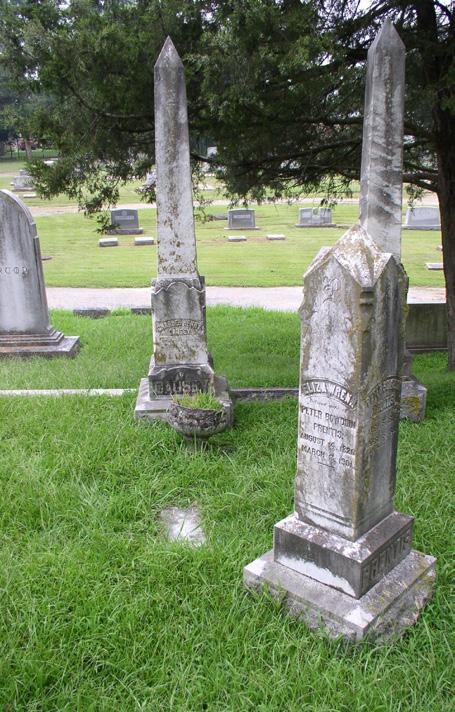
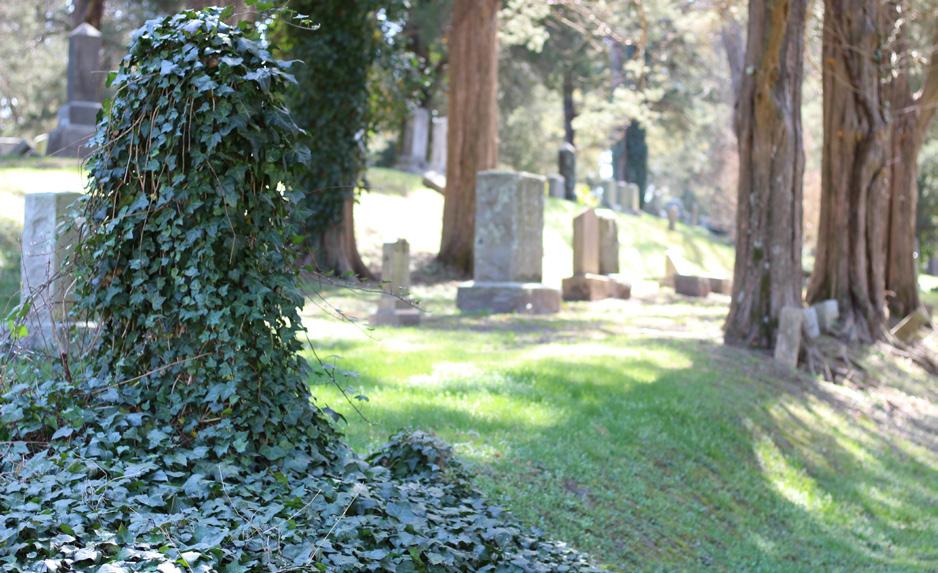






7
In 1802, the town of Suffolk, Virginia, purchased two and a half acres of an old family farm on the Nansemond River in order to build a community chapel. The Anglican Church had been abandoned at the end of the Revolutionary War. Townspeople attracted to new denominations and those who still favored the Book of Common Prayer needed a place to worship and to bury their loved ones . . .
. . . Thus began the long and colorful history of Cedar Hill Cemetery. It was once the home place of the Constant family, situated on a hill covered with cedar trees and just above a wharf where the city of Suffolk was established in 1742. The multi-denominational church built on the site was moved long ago, but the cemetery remains, a garden of great beauty and serenity. Its graves tell the history of a community almost as old as our country. It has survived much of American history, through river commerce during the American Revolution and vital railroad traffic during the War Between the States to the growth and development of the modern city of Suffolk. Both attention and neglect are etched on its stones and grow in the moss decorating its many structures.
Cedar Hill inspires pleasant walks which may lead to deeper study of lifestyles, families, and history. You will find many devices or designs that were likely to be immediately recognizable to people of an earlier era. The beautiful symbols carved into a headstone denoted something about the person interred there.
In interpreting symbols, you must be aware that sometimes there is more than one meaning for some of these symbols, so we cannot say with absolute certainty that we know the meaning that was intended. Only the relative who ordered the gravestone for the deceased knew exactly what those symbols signified. Today, we can only review what is written about the symbols, look at the life span of the individual, and then try to interpret these lovely motifs.
In old burying grounds, the graves are positioned east/ west, the most common orientation. The dead were buried with their feet pointing toward the east and the head of the coffin was toward the west. They were ready to rise up and face the “new day” (sun) when “the trumpet shall sound and the dead shall be raised” or when Christ would reappear and they would be reborn. Thus, even the placement of graves connotes meaning in a graveyard.
Anchor: Hope.
SYMBOLS
Angel: Rebirth or resurrection; spirituality, agents of God, guardians of the dead.
Clasped hands: Marriage, close bond, unity, affection even after death. The person who died first holds the other’s hand, guiding the spouse to heaven.
Daisy: Gentleness, youth.
Dove (flying): Resurrection.
Fern: Sincerity, sorrow.
Garland: Victory of the redemption.
Ivy: Immortality, fidelity, undying affection.
Lamb: Usually marks the grave of a child. Purity, innocence, sacrifice.
Lily: Majesty, often used on women’s graves, innocence, purity, resurrection. Restored innocence of soul at death.
Lily of the Valley: Purity, humility.
Morning Glory: Youth, resurrection, mourning, farewell, brevity of life.
Obelisk: From an Egyptian form; power, lord over all, creator.
Roses: Completion and the brevity of earthly existence. Love, beauty, hope unfailing love.
Bud of rose: Normallly a child under 13. Partial bloom: Usually a teenager.
Full bloom: Deceased died in prime of life. Rosette: The Lord, hope, promise, and love.
Scroll: Scriptures.
Scythe: Death.
Thistle: Earthly sorrow; Christ’s crown of thorsn, Scotland (country of origin).
Torch/Flame: Immortality of the spirit, resurrection. Inverted torch: Extinction of life. Death.
Tree: Life.
Trunk: shortened life. Severed branch: immortality.
Weeping Willow: Sorrow and mourning.
Wheat sheaves: Divine harvest; often represents the aged.
Information compiled by the Nansemond River Garden Club with special thanks to the SNHS and SCV. 8

9
Look for a monument with a praying angel for Claire, 1881-83. Also note the baby’s bed for Inez, with a dove at the head and the lamb at the foot. The “bed” is used to mark young children’s graves.



2. The Finney Sisters
The Finney sisters started a school for young ladies in Suffolk in 1869. Students came from all over Virginia and North Carolina. Tuition for boarders was about $160 per year. Part of the original building still exists near College Court on Main Street. On Martha Finney’s grave (183785) is a sheaf of wheat being cut by a scythe. Note the rosettes, and the lily and rose on top.
3. Riddick’s Obelisk
Look for the down-turned torches with a flaming urn on the top of the obelisk. Notice the garland, as well.
4. Darden Monument

This beautifully carved stone honors “the only son,” Archibald Allen, who died at 20 years of age. Note the very specific flowers and leaves which decorate his tomb—morning glory, ivy, fern, thistle, daisy, and lilies. To the Victorian, each of these had meaning and the stone might literally speak of the family’s feelings for their beloved through flowers.
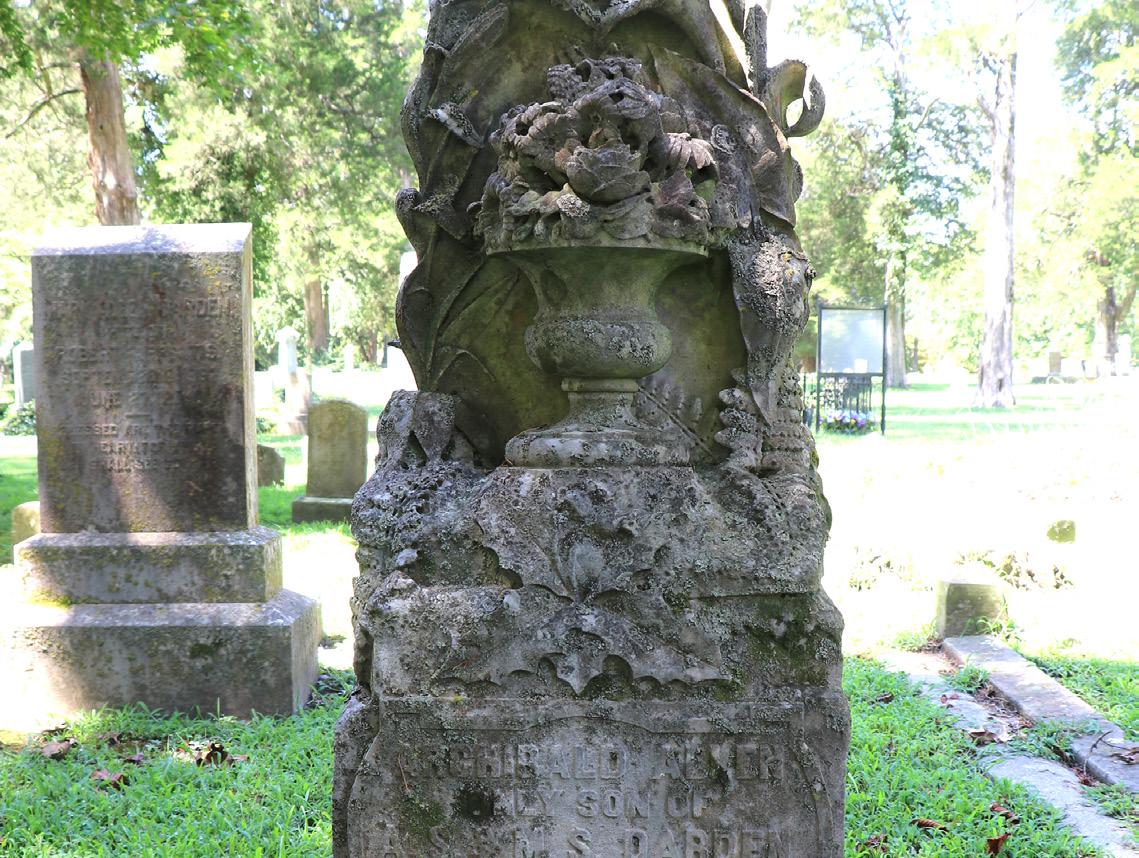 1. The Woodwards
1. The Woodwards
GRAVES OF NOTE 10
5. Lucy Allen (1841-1893)
The headstone has beautiful passion flowers.

6. Angel at the Obelisk
Literally pointing the way to heaven and symbolizing rebirth, protection and resurrection, the angel and her obelisk honor “Wm. H. Smith” and “Martha Jane Rountree, wife of J.E. Lassiter nee Wm. H. Smith.” Note the Victorian recognition of two marriages. Within this plot is Agnes P. Ashburn (lily), her husband, Isaac Walter Ashburn (clasped hands on the headstone), and their infant daughter, Minnie (lily of the valley).
7. Edward D. Hargroves (1846-1899)
On this obelisk is the symbol for the Freemasons (Masons): square, compass, and G (geometry or God).
*Notice the draped obelisks and urns as you walk. In Victorian times, black cloth was often placed on monuments.


8. Cylindrical Monument
This cylindrical moniment was typical of those shown in the Sears Tombstones and Monuments 1902 catalogue. This design is relatively rare in the southeast. Its bolster/ pillow shape may indicate that the deceased is at rest.

11
9. Dunn Plot
Hattie B. Dunn died at age 24. Her stone has a broken daffodil, signifying death of youth and beauty. Katie, 7 months and 10 days, has lily of the valley. May, only 15 when she died, has a scroll for her headstone. Notice the interesting footstones here.

11. Lion Trainer
Buried in the “potter’s field” area of Cedar Hill, a section reserved for strangers or people who could not afford their own gravesites, this unknown man died in the line of duty while his circus wintered in Suffolk.

When the War Between the States ended, Thomas Washington Smith, a Nansemond County native who was with General Lee at Appomattox, made his way home by foot. His dream was finally realized in November 1889, at a ceremony which included speeches by Governor Fitzhugh Lee and General D.H. Maury; thousands came by horse, carriage, trail, or on foot to remember the Confederate dead. Smith’s monument was made in two parts: the granite base was constructed by a Norfolk man, and the soldier is made of zinc cast in Bridgeport, Connecticut. Zinc was a metal used for grave markers between 1874 and 1930; these zinc monuments were produced under the name “white bronze.” All manufacturing ceased in 1930, and molds were melted down for the war effort in WW II. Zinc monuments are rare and can be identified in cemeteries by their blue-gray color and by the lack of moss and mildew on them.
 10. Confederate Monument
10. Confederate Monument
GRAVES OF NOTE 12
This unique monument honors a member of the “Woodmen of the World,” a service organization for youth which strives to teach character through job skills. This one is quite specific in the presentation of an anchor and a felled tree limb—a sailor’s life cut short.
The monument of Ida J. Whaley Parker, who died at age 26, is one of the most beautiful—trunk of a tree with its anchor, broken limb, ivy, and fern. The anchor was used by early Christians as a disguised cross.
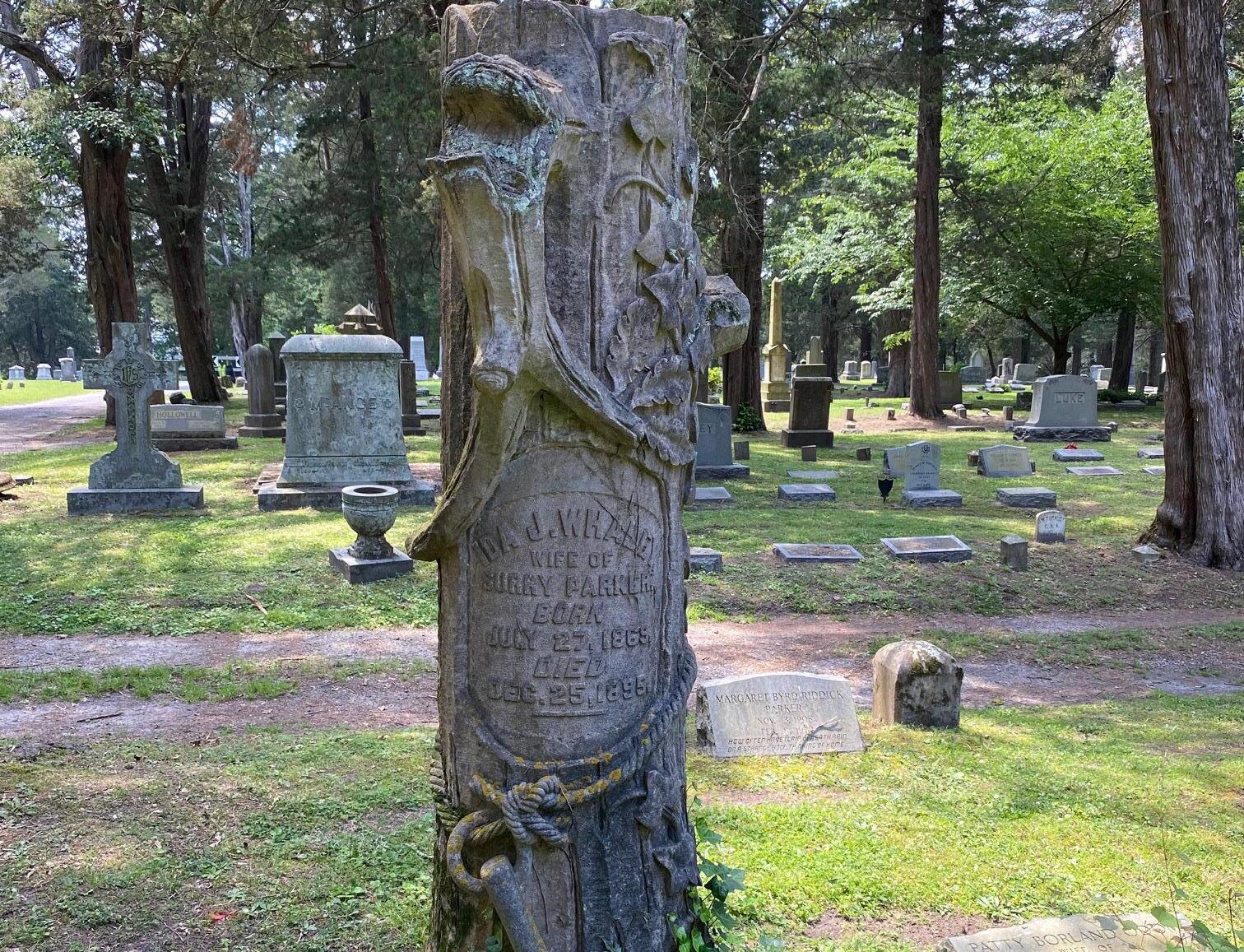
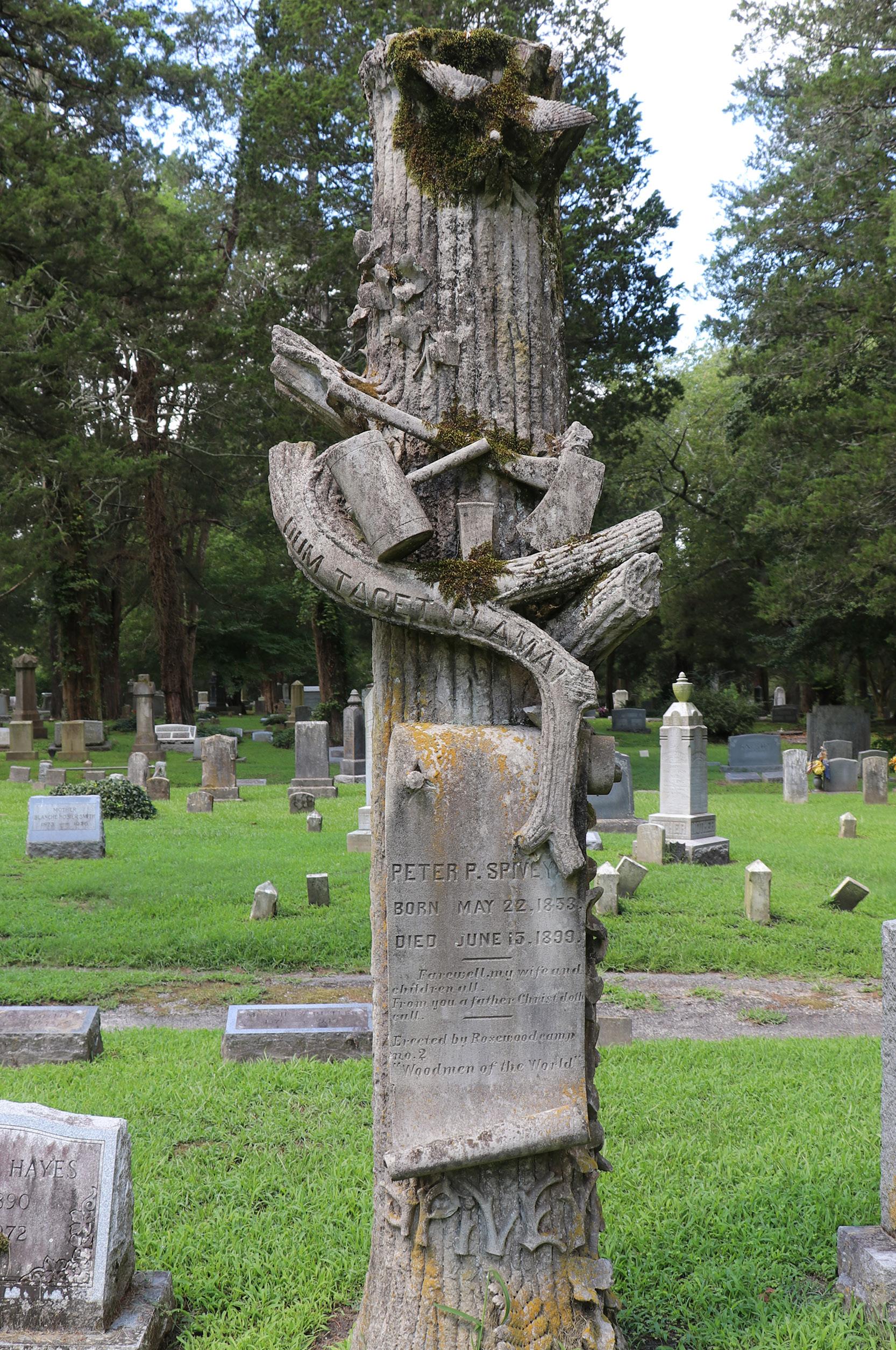
Lambs and angels were often used on infants’ and children’s graves in the nineteenth century. This is one of several examples in Cedar Hill. Note the Nurney family’s loss of “Susie Bartlett Nurney, 1884-1901,” barely 17 years old, and “J.H. Nurney, 1893-1895,” a baby of two years. Notice the wheat, thistle, and lamb in this plot.
 12. Woodsman’s Tree
13. Ida Whaley Parker
14. Nurney Angel and Lamb
12. Woodsman’s Tree
13. Ida Whaley Parker
14. Nurney Angel and Lamb
13
Anna Mary Riddick was the granddaughter of the man who built Riddick’s Folly, where she lived all her life. It is rumored that her fiancée was killed while serving the Confederacy and that she never married, stricken with grief. She founded the Suffolk chapter of the United Daughters of the Confederacy (UDC), serving as its president for 30 years.



There are several planned open areas in the old part of Cedar Hill, such as the area with the old fountain, where summer houses stood. In the Victorian period, families would take outings to the cemetery to enjoy the garden and also quite literally to be closer to deceased loved ones.
 15. Anna Maria Riddick
17. The Fountain
16. Mary Parker
18. James H. Smith (1864-1902)
Mrs. Mary Parker’s headstone has the weeping willow, signifying sorrow and mourning.
15. Anna Maria Riddick
17. The Fountain
16. Mary Parker
18. James H. Smith (1864-1902)
Mrs. Mary Parker’s headstone has the weeping willow, signifying sorrow and mourning.
GRAVES OF NOTE 14
Features a cross, anchor, and crown.
19. Brewer Godwin Mausoleum
A fine example of the mausoleums in Cedar Hill, this one honors one of Suffolk’s prominent families which included a statesman and a president of the Garden Club of Virginia.


20. Iron Fencing
Throughout Cedar Hill, iron fencing reflects the popularity of wrought and cast iron fencing and ornamentation during the nineteenth century. Much of Cedar Hill’s fencing may have been donated for melting down during the War Between the States and then not replaced. Sadly, too, incomplete fencing often reflects its popularity with vandals and architectural salvage yards.

15
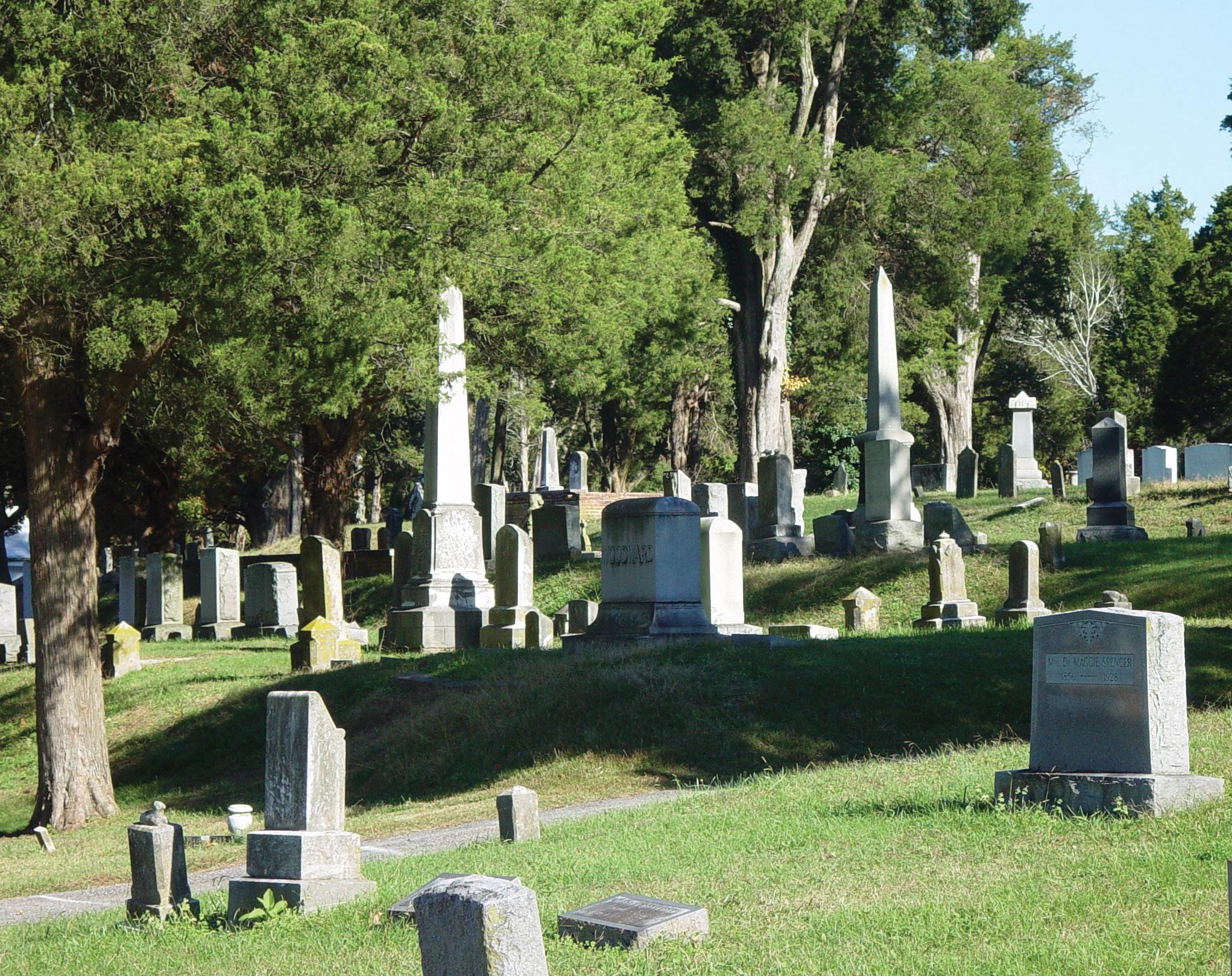


Suffolk Visitor Center Open Daily 9am - 5pm Closed Thanksgiving, Christmas, and New Year’s Day 524 North Main Street • Suffolk, VA 23434 757-514-4130 VisitSuffolk@suffolkva.us • VisitSuffolkVa.com






 Riddick’s Folly and The Nansemond County Courthouse
Engraving from John White’s drawing
Riddick’s Folly and The Nansemond County Courthouse
Engraving from John White’s drawing




 Drawing by Gertrude Riddick Pruden
History compiled by Kermit Hobbs, Dana Adams, and Sallie Sebrell for The Nansemond River Garden Club (P.O. Box 344, Suffolk, VA 23439)
Drawing by Gertrude Riddick Pruden
History compiled by Kermit Hobbs, Dana Adams, and Sallie Sebrell for The Nansemond River Garden Club (P.O. Box 344, Suffolk, VA 23439)

















 1. The Woodwards
1. The Woodwards






 10. Confederate Monument
10. Confederate Monument


 12. Woodsman’s Tree
13. Ida Whaley Parker
14. Nurney Angel and Lamb
12. Woodsman’s Tree
13. Ida Whaley Parker
14. Nurney Angel and Lamb



 15. Anna Maria Riddick
17. The Fountain
16. Mary Parker
18. James H. Smith (1864-1902)
Mrs. Mary Parker’s headstone has the weeping willow, signifying sorrow and mourning.
15. Anna Maria Riddick
17. The Fountain
16. Mary Parker
18. James H. Smith (1864-1902)
Mrs. Mary Parker’s headstone has the weeping willow, signifying sorrow and mourning.





